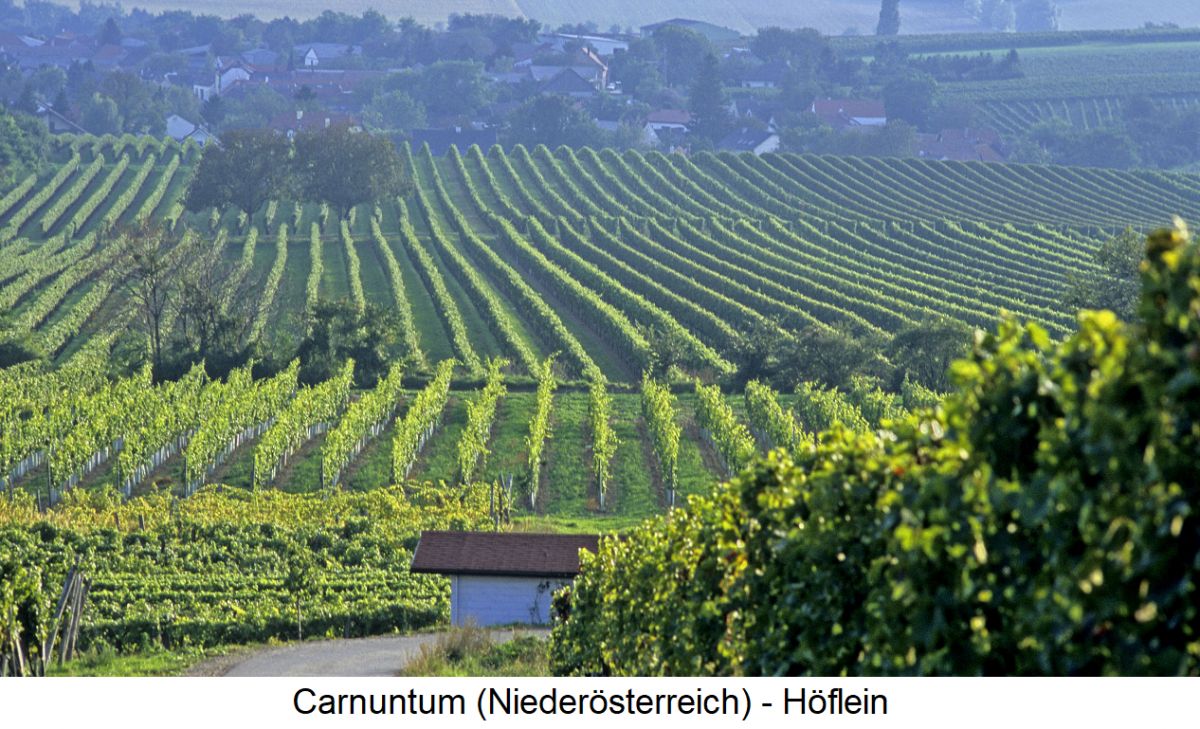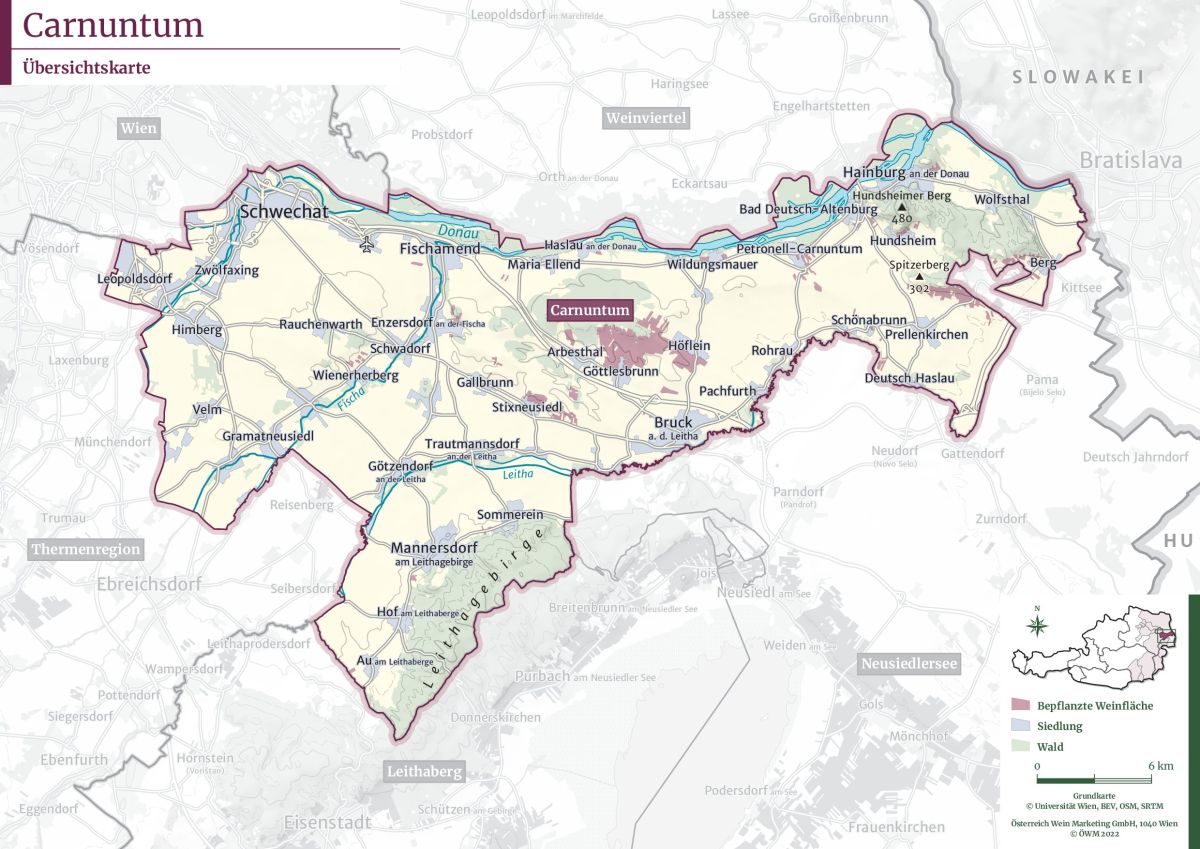Results
2,284 Results
Loading more Results ...
Loading more Results ...
| Carnuntum |
Description to Carnuntum
One of the eight specific wine-growing districts in the Austrian province or generic wine-growing region of Lower Austria. In 1993, the districts of Donauland (since the 2008 vintage Wagram) and Carnuntum, which until then had formed a common winegrowing area, were separated. The Celts and later the Romans already practised viticulture here. In the middle of the first century, the former Celtic kingdom of Noricum became a Roman province. The Romans built a legionary camp and a civilian city with a large amphitheatre near the village of Petronell, where the Amber Road crossed the Danube, which had about 40,000 inhabitants around 100 AD. The border against the Germanic tribes was fortified with a wall, the Limes. Extensive excavations were carried out in the 20th century. Outside the town, a former 20-metre-high triumphal arch commemorates the imperial conference in 308. Carnuntum was destroyed by the Germanic tribes around 400.

Climate & Soils
The hilly landscape stretches south of the Danube east of Vienna to the border of Slovakia. The vineyards are situated on the foothills of the thermal line (fracture zone with a number of thermal springs) and also benefit from the temperature balance of Lake Neusiedl and the Danube. The Pannonian climate influence, which is already strongly noticeable here, ensures high average summer temperatures and above-average grape ripeness, which creates excellent conditions for red wines. Sandy, loamy, loessy and gravelly soils predominate, which are mostly due to deposits of the Danube. Geologically, the area is part of the Vienna Basin.

Wine-growing communities
Some of the vineyards are widely scattered, but there are two major concentrations of contiguous areas. The sunny southern slopes of the Spitzerberg with the vineyard of the same name form a small red wine island near Prellenkirchen. The second larger area is around the three municipalities of Göttlesbrunn, Arbesthal and Höflein. Other wine-growing communities are Bruck an der Leitha, Edelstal (but belongs to Burgenland), Hainburg and Stixneusiedl. Well-known vineyards in the Carnuntum wine-growing region are Altenberg, Bärnreiser (Bärenreiser), Birnzipf, Bühl (with sub-vines Aubühl, Kirchbühl), Geizbillen, Gsetzen, Hagelsberg, Haidacker, Kräften, Neuberg, Rosenberg, Scheibner, Schüttenberg, Spitzerberg and Stuhlwerker.
Grape variety list
In 2022, the vineyards covered a total of 832 hectares of vines. Compared to 2015 with 907 hectares, this was a reduction of 75 hectares (9.3%). The share of red wine varieties is 56%, the share of white wine varieties 44%. Zweigelt dominates with more than a quarter of the total area, followed by Grüner Veltliner, Blaufränkisch, Merlot and Chardonnay.
Grape variety
|
in Austria
|
Colour |
HA
|
%
|
HA
|
%
|
| Zweigelt | Blue Zweigelt, Rotburger | red | 232 | 27,8 | 240 | 26,4 |
| Grüner Veltliner | Weißgipfler | white | 163 | 19,6 | 193 | 21,2 |
| Blaufränkisch | - | red | 95 | 11,4 | 84 | 9,2 |
| Merlot | - | red | 51 | 6,1 | 54 | 6,0 |
| Chardonnay | Morillon - not used in Lower Austria | white | 51 | 6,1 | 35 | 3,8 |
| Welschriesling | - | white | 40 | 4,8 | 50 | 5,5 |
| Muscat Blanc | Yellow M., Red M. / Muscat Blanc | white | 28 | 3,3 | 24 | 2,6 |
| Sauvignon Blanc | Muscat Sylvaner | white | 27 | 3,2 | 24 | 2,6 |
| White Burgundy | Pinot Blanc, Klevner | white | 21 | 2,5 | 27 | 3,0 |
| St. Laurent | - | red | 18 | 2,1 | 23 | 2,5 |
| Pinot Noir, Pinot Noir | Pinot Noir, Pinot Noir, Pinot Noir | red | 16,4 | 2,5 | 19 | 2,1 |
| Cabernet Sauvignon | - | red | 15 | 1,8 | 21 | 2,2 |
| Syrah | Shiraz | red | 11 | 1,3 | 12,3 | 1,4 |
| Roesler | - | red | 9,5 | 1,1 | 10,8 | 1,2 |
| White Riesling | Riesling, Rhine Riesling | white | 9 | 1,1 | 13,1 | 1,4 |
| Blauburger | - | red | 6,5 | 0,8 | 15,4 | 1,7 |
| Müller-Thurgau | Rivaner | white | 5,7 | 0,7 | 11,4 | 1,3 |
| Blue Portugieser | - | red | 2,5 | 0,3 | 6,6 | 0,7 |
| Neuburger | - | white | 2,3 | 0,3 | 4,4 | 0,5 |
| Scheurebe | seedling 88 | white | 2,2 | 0,3 | 2,1 | 0,2 |
| Roter Veltliner | - | white | 2,1 | 0,3 | 1,4 | 0,2 |
| Muscat Ottonel | - | white | 1,6 | 0,2 | 2,3 | 0,3 |
| Cabernet Franc | - | red | 1,5 | 0,2 | 1,6 | 0,2 |
| Traminer | Gewürztraminer, Red T., Yellow T. | white | 1,4 | 0,2 | 1,5 | 0,2 |
| Frühroter Veltliner | Malvasia | white | 1,3 | 0,2 | 1,0 | 0,1 |
| Bouvier | - | white | 1,1 | 0,1 | 1,1 | 0,1 |
| Goldburger | - | white | 1,1 | 0,1 | 1,0 | 0,1 |
| Muscaris | - | white | 0,9 | 0,1 | - | - |
| Rathay | - | red | 0,6 | 0,1 | 0,6 | 0,1 |
| Grey Burgundy | Pinot Gris, Ruländer | white | 0,4 | - | 0,7 | 0,1 |
| Sylvaner | Green Sylvaner | white | 0,3 | - | 0,4 | - |
| Furmint | - | white | 0,2 | - | 0,3 | - |
| Gold muscatel | - | white | 0,2 | - | - | - |
| Rose muscatel | - | red | 0,2 | - | - | - |
| Blue Wildbacher | - | red | 0,1 | - | - | - |
| Jubilee Vine | - | white | 0,1 | - | 0,2 | - |
| Rotgipfler | - | white | 0,1 | - | 0,2 | - |
| Souvignier gris | - | white | 0,1 | - | - | - |
| Zierfandler | Late red | white | 0,1 | - | 0,2 | - |
| other varieties | - | white/red | 15 | 1,8 | 30 | 3,3 |
WHITE SORT |
|
white |
365 |
44 |
414 |
46 |
RED SORT |
|
red |
467 |
56 |
493 |
54 |
TOTAL |
|
|
832 |
|
907 |
|
DAC system
Starting with the 2019 vintage, the origin-controlled quality level Carnuntum DAC was introduced. All other quality wines must be marketed with the origin Lower Austria, the country wines under the winegrowing region designation Weinland. In addition to the generally valid DAC conditions, special rules apply. The established Rubin Carnuntum brand for Zweigelt wines typical of the region remains in place parallel to the DAC regulation.
For white wines, the quality wine grape varieties Grüner Veltliner,Pinot Blanc and Chardonnay are permitted, for red wines Blaufränkisch and Zweigelt. Pure-varietal wines must be vinified exclusively from these, blends from at least two-thirds. This means that cuvées can also contain up to one third of other quality wine grape varieties, such as St. Laurent, Cabernet Sauvignon or Merlot for red wine.
There are three levels: regional wine, local wine (from a local wine-growing community, up to 15% from neighbouring communities) and estate wine ( estate registered in the wine-growing cadastre, up to 15% from neighbouring estates). The wines must be dry. Red wines must have at least 12% alcohol by volume. In addition, local and single vineyard wines wines should be given sufficient time to develop their independent and expressive character. The application to obtain the State Assay Number may not be made before 15 March in the case of white wine and before 1 November of the year following the harvest in the case of red wine.
Producers
Well-known producers of the Carnuntum wine-growing region are Artner Hannes, Böheim Johann, Dorli Muhr, Edelmann Christian, Glatzer Walter, Glock Günther, Grassl Philipp, Jahner Leo, Lager Markus, Markowitsch Gerhard, Markowitsch Lukas, Nepomukhof, Netzl Franz, Oppelmayer, Ott Stefan, Payr Robert, Pelzmann, Pimpel, Pitnauer, Schenzel-Wallner, Taferner Alois, Taferner Franz, Trapl and Zwickelstorfer. A well-known winegrowers' association is Traditionsweingüter Österreich.
Höflein: © ÖWM - Armin Faber
map: © ÖWM
Classified wine producers in Carnuntum 25
find+buy for Carnuntum 27
Recent wines 681
 Familie Pitnauer
— Lower Austria/Niederösterreich
2015 Carnuntum Ried Hagelsberg Grüner Veltliner Reserve trocken
87 WP
very good
15.00 €
Familie Pitnauer
— Lower Austria/Niederösterreich
2015 Carnuntum Ried Hagelsberg Grüner Veltliner Reserve trocken
87 WP
very good
15.00 €

 Weingut Lukas Markowitsch
— Lower Austria/Niederösterreich
2006 Carnuntum Ried Rosenberg Blaufränkisch trocken
89 WP
very good
17.00 €
Weingut Lukas Markowitsch
— Lower Austria/Niederösterreich
2006 Carnuntum Ried Rosenberg Blaufränkisch trocken
89 WP
very good
17.00 €

 Weingut Lukas Markowitsch
— Lower Austria/Niederösterreich
2019 Carnuntum trocken Cuvée Lukas
88 WP
very good
26.00 €
Weingut Lukas Markowitsch
— Lower Austria/Niederösterreich
2019 Carnuntum trocken Cuvée Lukas
88 WP
very good
26.00 €

 Weingut Lukas Markowitsch
— Lower Austria/Niederösterreich
2018 Carnuntum trocken Cuvée Lukas
90 WP
excellent
26.00 €
Weingut Lukas Markowitsch
— Lower Austria/Niederösterreich
2018 Carnuntum trocken Cuvée Lukas
90 WP
excellent
26.00 €

The most important grape varieties
More information in the magazine
- Where antiquity meets modern viticulture Wine-growing regions in Austria: Carnuntum
- In Focus: Grüner Veltliner The elegant ones are coming
- Carnuntum between drought and heat Blaufränkisch as a speciality of the primeval sea terroir
- Austria In Focus: Carnuntum Stop here on red!
- Austria In Focus Vienna and Carnuntum
- BEST OF Carnuntum The Zweigelt stronghold
- Austria In Focus Carnuntum - Red Majority
- Gerhard Markowitsch Redmont Cuvée 2010, Zweigelt-Blaufränkisch-Cabernet Sauvignon, Carnuntum, Austria
- The collections and discoveries of the year Tasting season 2023/2024
- The two unstoppables Blaufränkisch from Austria and Germany in comparison